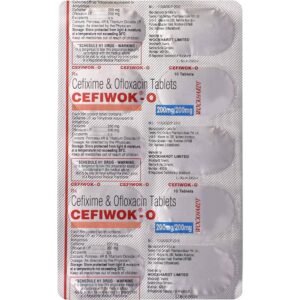CEFIXIME + OFLOXACIN AND CEFIXIME TAB
Cefixime: Cefixime is a prescription medication that belongs to a class of drugs called cephalosporins. It is commonly used to treat various bacterial infections, including respiratory tract infections, urinary tract infections, middle ear infections, and certain sexually transmitted infections.
The mechanism of action of Cefixime involves inhibiting the synthesis of bacterial cell walls. It does this by binding to certain enzymes called penicillin-binding proteins (PBPs) that are responsible for the cross-linking of peptidoglycan chains, a crucial component of bacterial cell walls. By inhibiting this process, Cefixime weakens the cell wall and ultimately leads to the death of susceptible bacteria.
The dosage of Cefixime can vary depending on the type and severity of the infection being treated. However, the usual adult dose for most infections is 400 mg taken orally once a day or divided into two doses of 200 mg every 12 hours. It is important to follow the prescribed dosage instructions provided by the healthcare provider.
Like any medication, Cefixime can cause side effects. Some common side effects include diarrhea, nausea, stomach pain, headache, and dizziness. These side effects are generally mild and temporary. However, if they persist or become severe, it is advisable to contact a healthcare provider. In rare cases, Cefixime can cause more serious side effects such as severe allergic reactions, which require immediate medical attention.
It is important to note that Cefixime is an antibiotic and should only be used to treat bacterial infections. It is not effective against viral infections such as the common cold or flu. Additionally, it is always recommended to complete the full course of treatment prescribed by your healthcare provider, even if the symptoms improve before the medication is finished. This helps to ensure the complete eradication of the bacterial infection and prevents the development of antibiotic resistance.
Ofloxacin And Cefixime Tab: Ofloxacin and Cefixime Tab is a combination medication that contains two active ingredients: Ofloxacin, an antibiotic belonging to the fluoroquinolone class, and Cefixime, a cephalosporin antibiotic. This combination is commonly used to treat various bacterial infections.
Ofloxacin works by inhibiting the enzymes responsible for DNA replication and DNA repair in bacteria, ultimately killing the bacteria or stopping its growth. Cefixime, on the other hand, interferes with the synthesis of the bacterial cell wall, leading to the weakening and destruction of the bacteria.
This combination medication is primarily used to treat respiratory tract infections, urinary tract infections, and sexually transmitted infections caused by susceptible bacteria. It is effective against a wide range of Gram-positive and Gram-negative bacteria.
The dosage of Ofloxacin and Cefixime Tab may vary depending on the specific infection being treated and the patient’s age and overall health. It is important to follow the prescribed dosage instructions provided by the healthcare professional or stated on the packaging.
As with any medication, there are potential side effects associated with Ofloxacin and Cefixime Tab. Common side effects may include nausea, diarrhea, headache, dizziness, abdominal pain, and rash. It is essential to inform a healthcare professional if any severe side effects occur, such as allergic reactions, severe diarrhea, tendon pain or swelling, or symptoms of liver problems.
It is crucial to take the full course of medication as prescribed, even if symptoms improve. Abruptly stopping the medication may lead to the recurrence of the infection and the development of antibiotic resistance. It is also important to avoid alcohol consumption while taking this medication, as it may increase the risk of certain side effects.
As always, it is recommended to consult with a healthcare professional or pharmacist for specific information about Ofloxacin and Cefixime Tab, including potential drug interactions and precautions before starting treatment.


